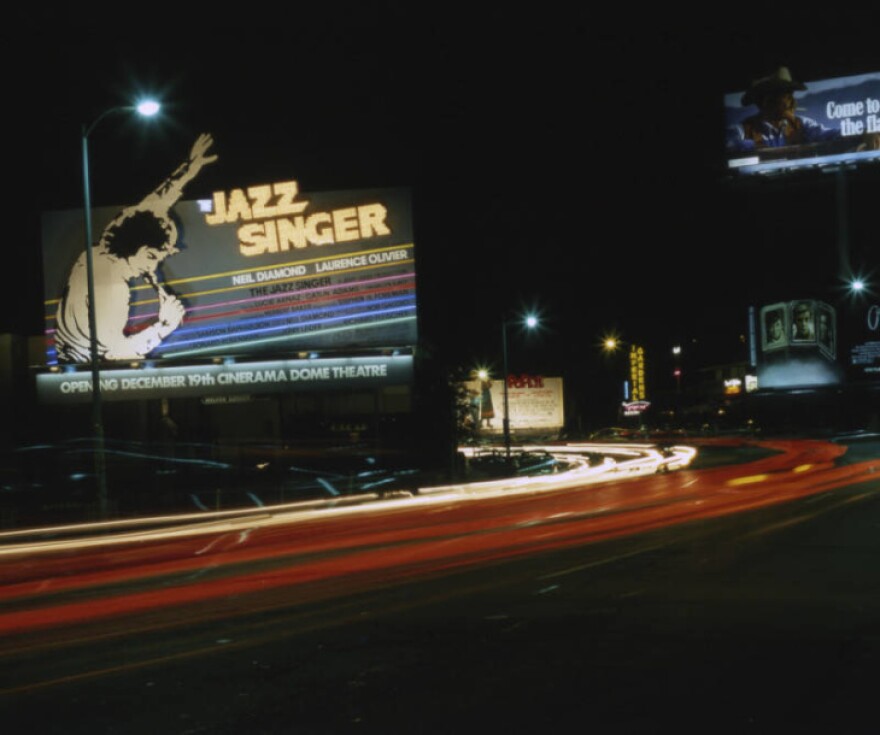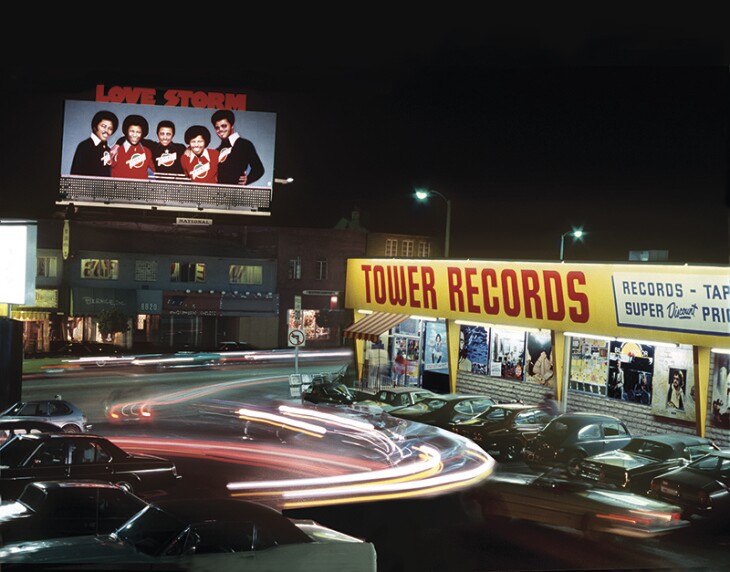Truth matters. Community matters. Your support makes both possible. LAist is one of the few places where news remains independent and free from political and corporate influence. Stand up for truth and for LAist. Make your year-end tax-deductible gift now.
The History Of The Sunset Strip Is Rich With Rock Stars, Mobsters And A Damn Good Maître D'

Los Angeles is a place full of big characters, both real and fictional. So it's only fitting that one of the region's most iconic streets is something of a character itself.
The Sunset Strip is anything but understated, in both its looks and the personalities it attracts. Over the years it's been a haven for big Hollywood actors, rock stars and even mobsters.
"The street has always responded to people who were unique and distinctive," said Van Gordon Sauter, author of Tales from the Strip: A Century in the Fast Lane and a former president of CBS News. Sauter's appreciation for the Strip grew out of his own experience living on Sunset Boulevard, when he got to know the area in a way he said many Angelenos don't. In a recent interview on KPCC's Take Two, Sauter noted the sometimes quirky personality of the Strip is something even a casual visitor should notice.
"Anybody who drives down this section of Sunset Boulevard and doesn't notice that it's different from where they left and where they're going is sort of tone deaf," he said.
The Strip -- which has officially been in West Hollywood since that city's founding in 1984 -- may be a well-known spot, but there's plenty of interesting history to discover.
ART DECO, GLITZ AND GLAMOUR

Arguably the most iconic building on the Strip is the Sunset Tower Hotel. Designed in 1929 with the Art Deco style of the roaring '20s, the tower embodies the glitz and glamour of the movie stars that lived there, including John Wayne, Marilyn Monroe and Elizabeth Taylor.
"It is emblematic of a golden time in Los Angeles history when the movie studios were thriving, where there was great self-indulgence," Sauter said.
The hotel may serve big name guests, but behind the scenes there's a man few have heard of who's kept it all running. Dimitri Dimitrov has spent years as maitre d' at the Tower Bar, catering to celebrities and everyday guests alike.
"To see him at work is awesome," Sauter said. "He's incredibly gracious, always moving, knows what everyone wants. And he likes to say that he treats a billionaire with the same respect, the same courtesy that he [gives] a tourist from Nebraska."
Dimitrov started in the hospitality industry at the young age of 19 and worked at swanky establishments like the Ritz Carlton in Montreal and L'Ermitage in Beverly Hills before taking his talents to Sunset.
REAL GANGSTERS, NOT-SO-TRUE DETECTIVES

In addition to starlets sipping cocktails, the Strip was home to a seedier scene. Infamous gangster Bugsy Siegel frequented the street and was even arrested at the Sunset Tower Hotel. L.A.'s own mob king, Mickey Cohen also left his mark on the Strip.
At least two shootings involving Cohen took place on the Strip. In 1948, gunman showed up at Cohen's clothing store on Sunset and killed one of his associates, Cohen was unharmed. Then, in 1949, Cohen was shot outside Sherry's restaurant while walking down the street.
"There was a mob presence here," Sauter said. "As there's always been a mob presence around show business and celebrity."
The Strip was home to some real-life criminals but it also played host to some not-so-real crime stories.
77 Sunset Strip was a television show that ran from 1958-1964 and followed the adventures of a group of private detectives, solving crimes out of an office located at (you guessed it) 77 Sunset Strip.
That's not a real address and most of the show was actually shot on a sound stage, but the opening credits were filmed at a restaurant called Dino's Lodge. As indicated by the large neon sign featuring Dean Martin's face, Dino's was a business venture for the famous rat pack singer, but in the end it wasn't a successful one.
"He had this restaurant which really had a very good clientele from the industry," Sauter said. "Suddenly after the show took over, all these tourists from Kansas and Ohio came in and began to stare at the celebrities or presumed celebrities, and the celebrities stopped going to Dean Martin's restaurant."
WHERE ROCK STARS ROAMED
Dino's wasn't the only establishment on the Strip that failed to stand the test of time. In the 1970s and '80s, Sunset became a hangout for some of the world's biggest rock stars. One of the spots most emblematic of that era was Tower Records.
"It was a place where not only the musicians in L.A. but the musicians visiting L.A. would go," Sauter said. "Because they had all the latest releases and if you were a musician and were here for a gig and you wondered what some competitor or some colleague's new record was like, that's where you'd go."

Tower was a renowned business frequented by the likes of Elton John and Bruce Springsteen, but the store's founder had smaller beginnings. Russ Solomon started out as a teenager selling records out of his father's pharmacy.
DOG DAYS
Although many businesses on the Strip, like Tower Records and Dino's, have come and gone, Sauter said the street's eclectic character will always remain because the street has always had room for unusual spots.
Where else would a tiny dog park sit at the foot of a hotel as stately as Sunset Tower? William S. Hart Park is named for the silent film era's biggest western star, whose house still stands on the property which he left to the city of L.A. Beside it is an off-leash dog park.

"I say most people haven't taken the time to come here," Sauter said. "I really think on some Saturday morning or some Sunday morning, it's worth driving up and down the street and looking at the changes and what's there... because it's an important part of the L.A. experience."
You made it! Congrats, you read the entire story, you gorgeous human. This story was made possible by generous people like you. Independent, local journalism costs $$$$$. And now that LAist is part of KPCC, we rely on that support. So if you aren't already, be one of us! Help us help you live your best life in Southern California. Donate now.







